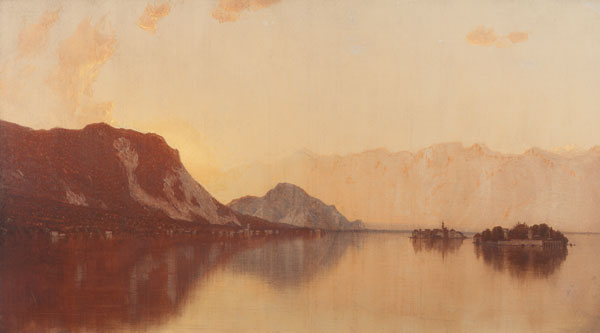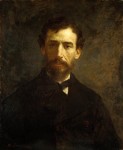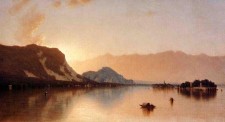
Sanford Gifford
American, 1823-1877
Isola Bella, Lago Maggiore, n.d.
oil on canvas
20 x 35 7/8 in.
SBMA, Gift of Dr. and Mrs. Ronald M. Lawrence
1981.52

Portrait of Sanford Robinson Gifford by Eastman Johnson n.d.
RESEARCH PAPER
This landscape painting by American artist Sanford Robinson Gifford is a peaceful one. Lago Maggiore, a large expanse of water, dominates the foreground. To the left lie the shoreline and an abrupt hill behind it. Some structures sit along the shore. In the center is another small hill. Rising out of the lake itself are two islands covered with vague buildings and various types of vegetation. A range of weakly defined mountains cuts off the background. This part of the composition appears unfinished because of pencil lines remaining. One could speculate that these lines might designate the intended structure, or that this is an oil sketch for another composition.
The painted surface is smooth, though some brush strokes are visible in the mountains. Gifford has used color, but the range is not too diverse. The painting has a luminous quality, as if seen through stained glass or a rosy sunrise through early morning mist, which demonstrates one of his beliefs: “Landscape painting is air-painting.” In 1856, while in Italy, he wrote in his journal:
“On the famous Isola Bella is that large and splendid palace of the Count Borroemo,
with gardens, terraces, statues, grottos, etc. From one point of view (side of Isola
Madre) the island, with its architecture and foliage is beautiful, but from other
points when a terraced and pinnacled pyramid is seen, it is too fantastic for good
taste.”
Yet it was from this “too fantastic” view that he painted Isola Bella, Lago Maggiore, selecting these special colors.
The son of a successful ironmonger, Gifford was born in Greenfield, New York, on July 10, 1823. Throughout his life, he had no financial worries, dropping out of Brown University after two years to pursue art. He studied under John Rubens Smith, an accomplished drawing master. Influenced by Thomas Cole, he soon gravitated to nature, to landscape painting, especially in the Catskill region.
Gifford first showed his work at the National Academy of Design in 1847. He was elected an Associate in 1851, and full Academician in 1854. In 1855, he left for Europe, travelling extensively for two years. While there, he was exposed to many styles of paining, but his own changed very little. He was troubled by Turner’s paintings, lamenting his abstract approach and lack of respect for the configurations and appearance of reality. John Ruskin tried to explain that Turner treated his subjects as would a poet, not as topographer.
The most obvious feature of Gifford’s mature art, which was both highly praised and severely criticized, was its color and luminous atmosphere. Gifford said: “The really important matter is not the natural object itself but the veil or medium through which we see it.” On the basis of such observations, a comparison of Gifford’s works could be misleading, as they have none of the visual characteristics of Impressionism proper.
Gifford was not a rebellious spirit, in either life or art. He had no unique vision, took no special risks, although he was one of the few artists to participate actively, if sporadically, in the Civil War in defense of Washington. His travels were extensive and leisurely, not only to Europe, but also to Egypt, Jerusalem, Lebanon, Syria, Greece and Turkey. In the United States, he made a West Coast trip, which included California, in 1874.
Basically Gifford was the epitome of a gentleman – earnest, dignified, tall, erect, with a nature unlike most artists. In 1877, at the age of 54, he was secretly married (why it had to be a secret is also a mystery). On August 29th, 1880, only three years later at age 57, he died of malaria and pneumonia. At the time of his death, he was held in high esteem, both as an artist and as a man. A memorial exhibition at the Metropolitan Museum contained 160 of his works. Yet in the twentieth century his paintings have lapsed into neglect. There was brief recognition in 1970-71 with three exhibitions organized by the University of Texas Art Museum, but no further enthusiasm. Does this bear out the opinions of a few critics in the nineteenth century who labeled his works as “Mannered, repetitive, empty, artificial?” Or is it possible to see these traits differently: stylish, subtle, luminous?
PROVENANCE
A few undetermined factors surround the landscape painting, Isola Bella, Lago Maggiore, which was donated to the Santa Barbara Museum of Art in 1981 by Dr. and Mrs. Donald M. Lawrence. The work was not signed by the artist, nor was it dated. The exact year it was painted is uncertain, although it is assumed that it was between 1856 and 1871.
In 1972 it was received by Hirsch & Adler Galleries, Inc., New York from “an unknown direct descendent.” Owners prior to this date are unknown. C. Peck representing this gallery wrote to SBMA on the 19th February 1982 saying, “There is not much recorded information….” Donor Lawrence, writing to SBMA on March 1, 1983 says, “It was purchased from Parke Bernet on April 25, 1980. Ex-collection Metropolitan Museum, New York. Details you need can be obtained from P.B. catalogue (sic) and Metrop. (sic) Museum.”
However, the only information forthcoming from Sotheby Parke Bernet’s publication, American 19th and 20th century Paintings, Drawings, Watercolours and Sculpture, sale 4365, April 25, 1980, lot 10, indicates that Isola Bella, Lago Maggiore was “withdrawn, passed on, or unsold.” Natalie Spasky, Associate Curator of American Paintings at the Metropolitan Museum of Art, in an August 10, 1982 letter to SBMA writes: “Your oil appears to be the preparatory study for the Metropolitan’s painting (photo enclosed). The work now in Santa Barbara is probably the ‘unfinished full-sized version’ Ila Weiss mentions… in her dissertation.” This refers to Dr. Ila Weiss’s Ph.D. dissertation, completed at Columbia University in 1968 titled “Sanford Robinson Gifford (1823-1880).” Dr. Weiss offers no definite information about the SBMA painting, but speaks of another version, Isola Bella in Lago Maggiore, oil on canvas 24” by 36”, signed S.R. Gifford, dated 1871, property of the Metropolitan Museum of Art, acquired as a gift in 1921.
BIBLIOGRAPHY
Tuckerman, Book of the Artists, by James F. Carr, N.Y., 1967.
Clement, Clara Erskine, Artists of the 19th Century, St Louis North Point, Inc., 1969.
Becker, Thieme, Allgemeines Lexikon der Bilderden Kunstler, by Seeman Leipzig, 1967.
Weiss, Ila, Sanford R. Gifford in Europe, A Sketchbook of 1868.
The American Art Journal, November, 1977, Volume 9, pp. 83-103.
Sotheby Parke Bernet, Inc. Catalog. American 18th Century, 19th Century and Western Paintings and Drawings and Sculpture. October 22, 1981.
Sotheby Parke Bernet, Inc. Catalog. American 19th and 20th Century Paintings, Drawings, Watercolours and Sculpture. Sale 4365, April 25th, 1980.
Prepared for the Santa Barbara Docent Council by Margo Petrie, 1984.
Prepared/typed for the SBMA Docent Council website by Gail Stichler, edited by Lori Mohr, fall 2012.

Isola Bella in Lago Maggiore, 1871, The Metropolitan Museum of Art.
COMMENTS
Gifford's second visit to the Italian Lake district in summer 1868 resulted in a painting that contrasts markedly with the pictures done of the same subject matter after his first visit in 1856. In those, taller picture proportions and high frontal sunlight made for bolder, more sculptured mountains and an amphitheatrically disposition of the setting. Here, the sun declining behind the alpine ridges generally flattens the terrain and, except for the warm palette, the picture evokes the landscapes of Gifford's colleague, John Frederick Kensett. Isola Bella is the island at right; with its terraced and pinnacled gardens, it was and remains a popular tourist attraction.
http://hoocher.com/Sanford_Robinson_Gifford/Sanford_Robinson_Gifford.htm
